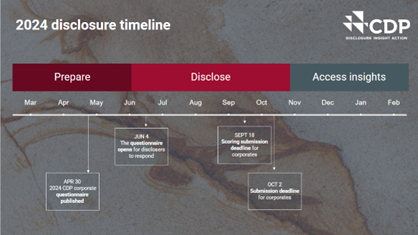Cority recently held a webinar focused on CDP reporting and how to best set up your organization for success in the 2024 reporting year and beyond. Our presenters included Jake Yeoell, Professional Services Manager (Cority), Karina Alventosa, Senior Sustainability Consultant (Cority), and Rosie Rust, Senior Engagement Manager (CDP).
During this webinar, we covered the reporting timeline of CDP and all changes in 2024. We also walked through best practices for preparing your data, how to navigate the regulatory landscape, and how to align CDP reporting activities with a wider sustainability strategy. This blog contains an overview of the subjects discussed.
New in 2024
This year, CDP implemented some exciting changes, showcased during the webinar. These include:
- A single, integrated corporate questionnaire. This replaces the individual climate change, forests and water security questionnaires. As a result, it reduces duplicated responses to encourage a more holistic approach to climate and nature disclosure.
- Increased alignment with standards and frameworks. For 2024, CDP is fully aligned with the IFRS S2 Standard, delivering the first S2-aligned dataset to the market. Additionally, there are plans to continue expanding alignment to TNFD, EFRAG, and the proposed U.S. SEC rules.
- A dedicated, simplified questionnaire for Small and Medium Enterprises (SMEs) to disclose to CDP. This aims to streamline the processes, ease burdens, and build confidence. The initial focus will be on climate change, with plans to integrate targeted forest and water data points, thus helping provide critical data continuity between these datasets.
- A new, more efficient disclosure Portal to continue supporting the exponential rise in disclosure. All in all, it encourages compliance teams to work more collaboratively to gather data and disclose in an agile way.
Reporting for 2024 is underway, as the corporate questionnaire was officially released. The disclosure cycle begins in early June, with the scoring submission deadline on September 18.

Setting You and Your Data Up for Success
There are several best practice tips to help prepare for the CDP cycle. The first stage is understanding your reporting criteria. It is important to build a strategy around CDP reporting to ensure alignment with all the key dates in the timeline. A solid understanding of the mechanics of the reporting pieces – including the latest questionnaire changes – will ease the process and ensure data accuracy.
For those who have reported previously, it is important to go back to submissions from prior years and associated score reports. As a result, this will help you understand any quick changes that are easy to implement, or long-term improvement opportunities to inform strategic planning.
Once your reporting criteria and overall aims are set, take sufficient time to plan and define a comprehensive data collection process. This can include:
- Establishing the sources and scope of the data required
- Setting key milestones and timelines
- Engaging and encouraging transparency with internal and external stakeholders early in the process to ensure clear understanding of roles and expectations
- Defining a robust internal verification process across all relevant departments and levels
- Assessing data quality and coverage challenges, to identify improvement opportunities
Calculating Emissions
As there is a large focus on corporate emissions data and performance within CDP reporting, it is essential to have a robust calculation process in place. With the myriad of methodologies, calculation approaches and reporting boundaries, it can be a daunting process undertake. To navigate this part of the reporting process, define a clear and comprehensive emissions inventory management plan. Also, it can be useful to prepare a document containing your emissions factor methodologies, sources of data and any estimation procedures.
Aim for complete data collection – covering emissions scopes, categories, and geographical locations. At the same time, consider whether there is a need to restate historic data. Additionally, where possible, use tools and technologies to help streamline the processes and integrate it into the CDP reporting process.
Navigating the Regulatory Landscape and Tips for Score Improvement
The CDP scoring process is complex, yet very transparent, and improvements in your score will only occur with tangible actions to reduce your organization’s impact. However, there are several ways to leverage your actions to improve your score:
- Understand your CDP score report from the prior year to learn how each section was assessed. This is a helpful guide for answering any repeat questions and outlining any opportunities for improvement this year. Also, CDP provides ample documentation with the scoring methodology and reporting guidance.
- As you work through the reporting process, ensure complete disclosure of all questions. The guidance provided, along with the updated portal, will be key in helping you understand what each question is asking for and helping craft the most effective response (instead of simply leaving fields blank!).
- Assess your status and ensure you are creating a strategy for improvement year over year. Once you are at the point where your data and draft responses are collected, you can conduct a mock score prior to submission. As a result, you will be able to do a thorough check to confirm that all necessary columns are completed, case studies are comprehensive, and your answers are evidence-based with quantitative information.
- After completion of a mock score, you can identify future targets and initiatives. The CDP questionnaire is highly correlated to tangible actions by you and your organization. Therefore, the more actions you take to mitigate your impact, the better your score will be.
- Data collection can be time-consuming, so it is helpful to align your CDP responses to other regulations and reporting activities. Utilizing tools that support with mapping and linking can allow for more efficient and aligned internal and external disclosures.
Cority and CDP
As a Gold accredited solution partner, Cority is proud to support CDP and align with its mission to provide a global disclosure system for investors, companies, and cities to manage their environmental impacts.
Our suite of dedicated tools operationalizes the CDP reporting process – including GHG Protocol aligned data collection, internal verification systems and workflow assistance, an API to automate the disclosure process and more.
Cority has over a decade of experience providing advisory services related to CDP, from mock-scoring exercises to fully outsourced CDP response project management. Our dedicated, award-winning team can support with:
- Calculating a predicted CDP score
- Highlighting short-term and long-term opportunities
- Providing ongoing support to improve client internal initiatives and align organizational strategy with CDP disclosure
- Project management of the entire submission process
Get in touch with our experts today to learn more.
Discover the latest news and stay up to date with all the changes regarding CDP disclosure.











